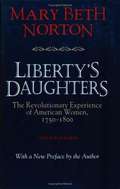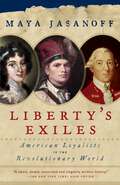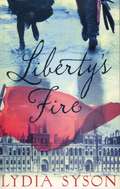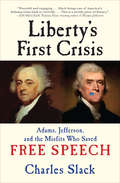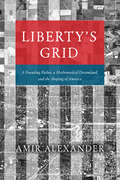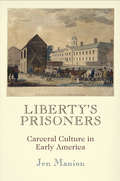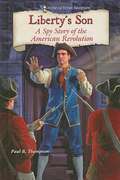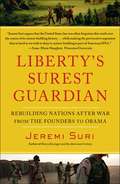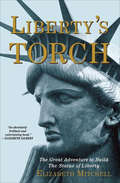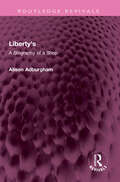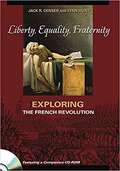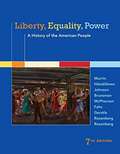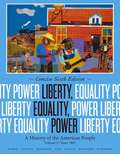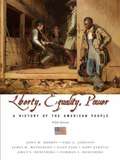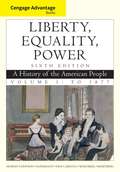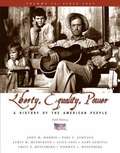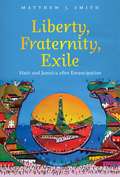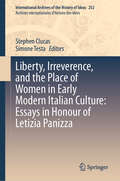- Table View
- List View
Liberty's Daughters: The Revolutionary Experience of American Women 1750-1800
by Mary NortonWhile the men were making the history you read in school, this is what the women were doing and thinking during the 1760s 70s 80s and 90s. Norton's] first concern ... is to trace the decline of patriarchy; the growth of free choice of a spouse; the rise of marital equality; . . . the greater equality in educational attainments; the more intense concern of parents for the proper education of children; the greater permissiveness in child- rearing; and the increased cooperation between spouses in birth control. . . . [Her] fascinating documentation, drawn from a vast range of manuscript sources, establishes the facts beyond any reasonable doubt. . . . Norton suggests that the change resulted from . . . two factors. The first was the practical experience of women during the long years of revolutionary upheaval. .. . The second . . . was the impact of egalitarian and republican ideology."-Lawrence Stone, New York Times Book Review "Liberty's Daughters represents social history on a grand scale, imaginatively conceived and massively researched. Norton brilliantly portrays a dramatic transformation of women's private lives in the wake of the Revolution. This is a fascinating human story; Norton tells it marvelously well, with lively anecdotes and revealing details from the personal papers of some 450 eighteenth-century families." - Robert A. Gross, William and Mary Quarterly
Liberty's Dawn: A People's History of the Industrial Revolution
by Emma Griffin&“Emma Griffin gives a new and powerful voice to the men and women whose blood and sweat greased the wheels of the Industrial Revolution&” (Tim Hitchcock, author of Down and Out in Eighteenth-Century London). This &“provocative study&” looks at hundreds of autobiographies penned between 1760 and 1900 to offer an intimate firsthand account of how the Industrial Revolution was experienced by the working class (The New Yorker). The era didn&’t just bring about misery and poverty. On the contrary, Emma Griffin shows how it raised incomes, improved literacy, and offered exciting opportunities for political action. For many, this was a period of new, and much valued, sexual and cultural freedom. This rich personal account focuses on the social impact of the Industrial Revolution, rather than its economic and political histories. In the tradition of bestselling books by Liza Picard, Judith Flanders, and Jerry White, Griffin gets under the skin of the period and creates a cast of colorful characters, including factory workers, miners, shoemakers, carpenters, servants, and farm laborers. &“Through the &‘messy tales&’ of more than 350 working-class lives, Emma Griffin arrives at an upbeat interpretation of the Industrial Revolution most of us would hardly recognize. It is quite enthralling.&” —The Oldie magazine &“A triumph, achieved in fewer than 250 gracefully written pages. They persuasively purvey Griffin&’s historical conviction. She is intimate with her audience, wooing it and teasing it along the way.&” —The Times Literary Supplement &“An admirably intimate and expansive revisionist history.&” —Publishers Weekly
Liberty's Exiles: American Loyalists in the Revolutionary World
by Maya JasanoffNATIONAL BOOK CRITICS CIRCLE AWARD WINNER • This groundbreaking book offers the first global history of the loyalist exodus to Canada, the Caribbean, Sierra Leone, India, and beyond. At the end of the American Revolution, sixty thousand Americans loyal to the British cause fled the United States and became refugees throughout the British Empire. Liberty's Exiles tells their story.&“A smart, deeply researched and elegantly written history.&” —New York Times Book Review This surprising account of the founding of the United States and the shaping of the post-revolutionary world traces extraordinary journeys like the one of Elizabeth Johnston, a young mother from Georgia, who led her growing family to Britain, Jamaica, and Canada, questing for a home; black loyalists such as David George, who escaped from slavery in Virginia and went on to found Baptist congregations in Nova Scotia and Sierra Leone; and Mohawk Indian leader Joseph Brant, who tried to find autonomy for his people in Ontario. Ambitious, original, and personality-filled, this book is at once an intimate narrative history and a provocative analysis that changes how we see the revolution&’s &“losers&” and their legacies.
Liberty's Fire
by Lydia SysonParis, 1871. Four young people will rewrite their destinies. Paris is in revolt. After months of siege at the hands of the Prussians, a wind of change is blowing through the city, bringing with it murmurs of a new revolution. Alone and poverty-stricken, sixteen-year-old Zephyrine is quickly lured in by the ideals of the city's radical new government, and she finds herself swept away by its promises of freedom, hope, equality and rights for women. But she is about to be seduced for a second time, following a fateful encounter with a young violinist. Anatole's passion for his music is soon swiftly matched only by his passion for this fierce and magnificent girl. He comes to believe in Zephyrine's new politics - but his friends are not so sure. Opera singer Marie and photographer Jules have desires of their own, and the harsh reality of life under the Commune is not quite as enticing for them as it seems to be for Anatole and Zephyrine. And when the violent reality of revolution comes crashing down at their feet, can they face the danger together - or will they be forced to choose where their hearts really lie?
Liberty's First Crisis: Adams, Jefferson, and the Misfits Who Saved Free Speech
by Charles SlackWhen the United States government passed the Bill of Rights in 1791, its uncompromising protection of speech and of the press were unlike anything the world had ever seen before. But by 1798, the once-dazzling young republic of the United States was on the verge of collapse: partisanship gripped the weak federal government, British seizures threatened American goods and men on the high seas, and war with France seemed imminent as its own democratic revolution deteriorated into terror. Suddenly, the First Amendment, which protected harsh commentary of the weak government, no longer seemed as practical. So that July, President John Adams and the Federalists in control of Congress passed an extreme piece of legislation that made criticism of the government and its leaders a crime punishable by heavy fines and jail time. In Liberty’s First Crisis, writer Charles Slack tells the story of the 1798 Sedition Act, the crucial moment when high ideals met real-world politics and the country’s future hung in the balance.From a loudmouth in a bar to a firebrand politician to Benjamin Franklin’s own grandson, those victimized by the Sedition Act were as varied as the country’s citizenry. But Americans refused to let their freedoms be so easily dismissed: they penned fiery editorials, signed petitions, and raised "liberty poles,” while Vice President Thomas Jefferson and James Madison drew up the infamous Kentucky and Virginia Resolutions, arguing that the Federalist government had gone one step too far. Liberty’s First Crisis vividly unfolds these pivotal events in the early life of the republic, as the Founding Fathers struggled to define America off the page and preserve the freedoms they had fought so hard to create.
Liberty's Grid: A Founding Father, a Mathematical Dreamland, and the Shaping of America
by Amir AlexanderThe surprising history behind a ubiquitous facet of the United States: the gridded landscape. Seen from an airplane, much of the United States appears to be a gridded land of startling uniformity. Perpendicular streets and rectangular fields, all precisely measured and perfectly aligned, turn both urban and rural America into a checkerboard landscape that stretches from horizon to horizon. In evidence throughout the country, but especially the West, the pattern is a hallmark of American life. One might consider it an administrative convenience—an easy way to divide land and lay down streets—but it is not. The colossal grid carved into the North American continent, argues historian and writer Amir Alexander, is a plan redolent with philosophical and political meaning. In 1784 Thomas Jefferson presented Congress with an audacious scheme to reshape the territory of the young United States. All western lands, he proposed, would be inscribed with a single rectilinear grid, transforming the natural landscape into a mathematical one. Following Isaac Newton and John Locke, he viewed mathematical space as a blank slate on which anything is possible and where new Americans, acting freely, could find liberty. And if the real America, with its diverse landscapes and rich human history, did not match his vision, then it must be made to match it. From the halls of Congress to the open prairies, and from the fight against George III to the Trail of Tears, Liberty’s Grid tells the story of the battle between grid makers and their opponents. When Congress endorsed Jefferson’s plan, it set off a struggle over American space that has not subsided. Transcendentalists, urban reformers, and conservationists saw the grid not as a place of possibility but as an artificial imposition that crushed the human spirit. Today, the ideas Jefferson associated with the grid still echo through political rhetoric about the country’s founding, and competing visions for the nation are visible from Manhattan avenues and Kansan pastures to Yosemite’s cliffs and suburbia’s cul-de-sacs. An engrossing read, Liberty’s Grid offers a powerful look at the ideological conflict written on the landscape.
Liberty's Prisoners: Carceral Culture in Early America (Early American Studies)
by Jen ManionLiberty's Prisoners examines how changing attitudes about work, freedom, property, and family shaped the creation of the penitentiary system in the United States. The first penitentiary was founded in Philadelphia in 1790, a period of great optimism and turmoil in the Revolution's wake. Those who were previously dependents with no legal standing—women, enslaved people, and indentured servants—increasingly claimed their own right to life, liberty, and happiness. A diverse cast of women and men, including immigrants, African Americans, and the Irish and Anglo-American poor, struggled to make a living. Vagrancy laws were used to crack down on those who visibly challenged longstanding social hierarchies while criminal convictions carried severe sentences for even the most trivial property crimes.The penitentiary was designed to reestablish order, both behind its walls and in society at large, but the promise of reformative incarceration failed from its earliest years. Within this system, women served a vital function, and Liberty's Prisoners is the first book to bring to life the experience of African American, immigrant, and poor white women imprisoned in early America. Always a minority of prisoners, women provided domestic labor within the institution and served as model inmates, more likely to submit to the authority of guards, inspectors, and reformers. White men, the primary targets of reformative incarceration, challenged authorities at every turn while African American men were increasingly segregated and denied access to reform.Liberty's Prisoners chronicles how the penitentiary, though initially designed as an alternative to corporal punishment for the most egregious of offenders, quickly became a repository for those who attempted to lay claim to the new nation's promise of liberty.
Liberty's Provenance: The Evolution of the Liberty Ship from Its Sunderland Origins
by John Henshaw&“Deserves consideration from anyone interested in how the ship design process is translated into actual product which in turn can win a war.&” —Warship International The Battle of the Atlantic, fought by the Allies to maintain lines of communication and vital trade routes for armaments, men, and basic sustenance, could not have been won without the 2,710 Liberty ships that were designed and built for those critical one-way voyages to Europe—more than one voyage was considered a bonus. The kudos for the Liberty&’s construction rightfully belongs to America, but few people know that the groundwork for the shape of the hull and its basic hydrodynamics took place in the North Sands shipyard of Joseph Thompson & Sons Ltd on the banks on the River Wear in Sunderland, England. This new book follows the path of the critical designs that flowed from Thompson&’s shipyard, commencing with SS Embassage in 1935, to SS Dorington Court in 1939, through the SS Empire Wind/Wave series for the Ministry of War Transport in 1940 to SS Empire Liberty in 1941. These led to the sixty Ocean Class vessels built by Henry J. Kaiser and, from these, the Liberty ship was adapted by American naval architects Gibbs & Cox who, to this very day, still claim they designed the Liberty ship. With the use of beautifully drawn ship profiles, starting with World War I designs, then the critical designs from Thompson&’s shipyard, and particularly a drawing comparing the Liberty ship with its British progenitor, the author demonstrates just how much of the former was borrowed from the latter. While some credit has been given to Thompson&’s designs, this new book offers the first real proof as to the direct link between his work, the Empire Liberty/Ocean Class, and the Liberty ship that followed. In addition, the book demonstrates the versatility of the Liberty ship and explores those that were developed for specialist use, from hospital ships and mule transports to nuclear-age missile range ships.
Liberty's Son: A Spy Story Of The American Revolution
by Paul B. ThompsonIn 1773, seventeen-year-old apothecary Oliver Carter moves to Boston and begins helping the Sons of Liberty in their rebellion against British tyranny in the colonies as well as discovering that his boss, Dr. Benjamin Church, is a traitor to the cause.
Liberty's Surest Guardian
by Jeremi SuriAmericans are a nation-building people, and in Liberty's Surest Guardian, Jeremi Suri--Nobel Fellow and leading light in the next generation of policy makers--looks to America's history to see both what it has to offer failed states around the world and what it should avoid. Far from being cold imperialists, Americans have earnestly attempted to export their invention of representative government. We have had successes (Reconstruction after the American Civil War, the Philippines, Western Europe) and failures (Vietnam), and we can learn a good deal from both. Nation-building is in America's DNA. It dates back to the days of the American Revolution, when the founding fathers invented the concept of popular sovereignty--the idea that you cannot have a national government without a collective will. The framers of the Constitution initiated a policy of cautious nation-building, hoping not to conquer other countries, but to build a world of stable, self-governed societies that would support America's way of life. Yetno other country has created more problems for itself and for others by intervening in distant lands and pursuing impractical changes. Nation-building can work only when local citizens "own it," and do not feel it is forced upon them. There is no one way to spread this idea successfully, but Suri has mined more than two hundred years of American policy in order to explain the five "P"s of nation-building: PARTNERS: Nation-building always requires partners; there must be communication between people on the ground and people in distant government offices. PROCESS: Human societies do not follow formulas. Nation-building is a process which does not produce clear, quick results. PROBLEM-SOLVING: Leadership must start small, addressing basic problems. Public trust during a period of occupation emerges from the fulfillment of basic needs. PURPOSE: Small beginnings must serve larger purposes. Citizens must see the value in what they're doing. PEOPLE: Nation-building is about people. Large forces do not move history. People move history. Our actions in Iraq, Afghanistan, and Libya will have a dramatic impact on international stability. Jeremi Suri, provocative historian and one of Smithsonian magazine's "Top Young Innovators," takes on the idea of American exceptionalism and turns it into a playbook for President Obama over the next, vital few years.
Liberty's Surest Guardian: American Nation-Building from the Founders to Obama
by Jeremi SuriAmericans are a nation-building people, and in Liberty's Surest Guardian, Jeremi Suri--Nobel Fellow and leading light in the next generation of policy makers--looks to America's history to see both what it has to offer failed states around the world and what it should avoid. Far from being cold imperialists, Americans have earnestly attempted to export their invention of representative government. We have had successes (Reconstruction after the American Civil War, the Philippines, Western Europe) and failures (Vietnam), and we can learn a good deal from both. Nation-building is in America's DNA. It dates back to the days of the American Revolution, when the founding fathers invented the concept of popular sovereignty--the idea that you cannot have a national government without a collective will. The framers of the Constitution initiated a policy of cautious nation-building, hoping not to conquer other countries, but to build a world of stable, self-governed societies that would support America's way of life. Yetno other country has created more problems for itself and for others by intervening in distant lands and pursuing impractical changes. Nation-building can work only when local citizens "own it," and do not feel it is forced upon them. There is no one way to spread this idea successfully, but Suri has mined more than two hundred years of American policy in order to explain the five "P"s of nation-building: PARTNERS: Nation-building always requires partners; there must be communication between people on the ground and people in distant government offices. PROCESS: Human societies do not follow formulas. Nation-building is a process which does not produce clear, quick results. PROBLEM-SOLVING: Leadership must start small, addressing basic problems. Public trust during a period of occupation emerges from the fulfillment of basic needs. PURPOSE: Small beginnings must serve larger purposes. Citizens must see the value in what they're doing. PEOPLE: Nation-building is about people. Large forces do not move history. People move history. Our actions in Iraq, Afghanistan, and Libya will have a dramatic impact on international stability. Jeremi Suri, provocative historian and one of Smithsonian magazine's "Top Young Innovators," takes on the idea of American exceptionalism and turns it into a playbook for President Obama over the next, vital few years.
Liberty's Torch: The Great Adventure to Build The Statue of Liberty
by Elizabeth MitchellThe Statue of Liberty is one of the most recognizable monuments in the world, a powerful symbol of freedom and the American dream. For decades, the myth has persisted that the statue was a grand gift from France, but now Liberty's Torch reveals how she was in fact the pet project of one quixotic and visionary French sculptor, Frédéric Auguste Bartholdi. Bartholdi not only forged this 151-foot-tall colossus in a workshop in Paris and transported her across the ocean, but battled to raise money for the statue and make her a reality.A young sculptor inspired by a trip to Egypt where he saw the pyramids and Sphinx, he traveled to America, carrying with him the idea of a colossal statue of a woman. There he enlisted the help of notable people of the age—including Ulysses S. Grant, Joseph Pulitzer, Victor Hugo, Gustave Eiffel, and Thomas Edison—to help his scheme. He also came up with inventive ideas to raise money, including exhibiting the torch at the Phildaelphia world's fair and charging people to climb up inside. While the French and American governments dithered, Bartholdi made the statue a reality by his own entrepreneurship, vision, and determination.
Liberty's: A Biography of a Shop (Routledge Revivals)
by Alison AdburghamFirst published in 1975, Liberty’s is the biography of a shop and its various owners in London. Responding to the social pressures, class patterns, and governmental policies, the developments in the shop mimic the social changes taking place in London. It is affected by war and depressions, by trade booms and enemy bombs, by changes in fashions and taste. Liberty’s not only reflected these changes but also contributed to the artistic movements and the development of fashionable taste. This book will be of interest to students of history, fashion and sociology.
Liberty, Equality, Fraternity: Exploring The French Revolution (G - Reference,information And Interdisciplinary Subjects Ser.)
by Lynn Hunt Jack R. MasonLiberty, Equality, Fraternity offers readers an accessible and lively introduction to the French Revolution that is also grounded in the latest and most sophisticated historical scholarship. It does so through two paths―a book and a companion CD-ROM. The book gives a brief but comprehensive narrative of the Revolution. The CD-ROM offers readers an unprecedented multimedia overview of the Revolution through images, primary documents, and song. Together they introduce readers to the fascinating story of the world’s first great revolution. The book, written by Lynn Hunt and Jack Censer, preeminent authorities on the French Revolution, includes selected images and documents from the accompanying CD-ROM, prepared by the authors with the support of the Center for History and New Media at George Mason University and the American Social History Project at City University of New York. Features of the CD-ROM include primary documents (carefully chosen, translated, and placed in their proper historical contexts by a team of historians), songs, maps, and more than 300 images (caricatures, portraits, sculptures, and photographs of artifacts of material culture)―many previously available only to specialists in the field. These hard-to-find images, gathered from repositories in France and the United States, comprise an unparalleled and powerful visual record of the Revolution. Given the centrality of visual artifacts (imagery, symbolism, and print culture) to the history of the Revolution, and the inability of print reproduction to present such images with clarity and detail, the companion CD-ROM will provide an entry into the Revolution unavailable in any other form.
Liberty, Equality, Power: A History Of The American People
by John M. Murrin Paul E. Johnson Denver Brunsman James M. McPherson Pekka HämäläinenUnderstanding the past helps us navigate the present and future. This book teaches readers about American history and exposes them to movies and other forms of popular culture that tell the stories of the nation's past. A highly respected and thoroughly modern approach to U.S. history, LIBERTY, EQUALITY, POWER, Seventh Edition, shows how the United States was transformed, in a relatively short time, from a land inhabited by hunter-gatherer and agricultural Native American societies into the most powerful industrial nation on Earth. This approach helps readers understand the impact of the notions of liberty and equality, which are often associated with the American story, and recognize how dominant and subordinate groups have affected and been affected by the ever-shifting balance of power.
Liberty, Equality, Power: A History Of The American People (Liberty, Equality, Power #Vol. 11)
by John M. Murrin Paul E. Johnson Pekka HämäläinenNIMAC-sourced textbook
Liberty, Equality, Power: A History Of The American People Since 1863
by Paul Johnson Gary Gerstle Alice Fahs James McPherson John Murrin Emily Rosenberg Norman RosenbergHow did America transform itself, in a relatively short time, from a land inhabited by hunter-gatherer and agricultural Native American societies into the most powerful industrial nation on earth? You'll find out in LIBERTY, EQUALITY, POWER: A HISTORY OF THE AMERICAN PEOPLE, CONCISE Sixth Edition. The authors tell this story through the lens of three major themes: liberty, equality, and power. You'll learn not only the impact of the notions of liberty and equality but also how dominant and subordinate groups have affected and been affected by the ever-shifting balance of power.
Liberty, Equality, Power: A History of the American People
by James M. Mcpherson Gary Gerstle Emily S. Rosenberg Norman L. Rosenberg John M. Murrin Alice Fahs Paul E. JohnsonIntegrating social and cultural history, this college textbook tells the political story of a country that, over a relatively brief period, transformed itself into the most powerful nation on earth, and explores the role of power in shaping American politics, society, and economics. The fifth edition adds a final chapter on Presidents Clinton and Bush. Annotation ©2007 Book News, Inc., Portland, OR (booknews.com)
Liberty, Equality, Power: A History of the American People (Sixth Edition)
by James M. Mcpherson Emily S. Rosenberg Norman L. Rosenberg John M. Murrin Alice Fahs Paul E. Johnson Gary CerstleThe book integrates social and cultural history into a political story that is organized around the themes of liberty, equality, and power.
Liberty, Equality, Power: A History of the American People (Third Edition)
by James M. Mcpherson Gary Gerstle Emily S. Rosenberg Norman L. Rosenberg John M. Murrin Paul E. JohnsonAs part of the effort to write the clearest, most complete, and most accurate history possible, the authors of this book have included study aids to help one interpret and relate to the stories of the past.
Liberty, Equality, Power: Since 1863
by James M. Mcpherson Paul Johnson Gary Gerstle Emily S. Rosenberg Norman L. Rosenberg John M. MurrinAmerican history textbook.
Liberty, Equality, Power: To 1877 (6th Edition)
by James M. Mcpherson Gary Gerstle John M. Murrin Alice Fahs Paul E. JohnsonDeveloped to meet the demand for a low-cost, high-quality history book, this economically priced version of LIBERTY, EQUALITY, POWER, Sixth Edition offers the complete narrative while limiting the number of features, photos, and maps. All volumes feature a paperback, two-color format that appeals to those seeking a comprehensive, trade-sized history text. A highly respected, balanced, and thoroughly modern approach to U. S. History, LIBERTY, EQUALITY, POWER uses these three themes in a unique approach to show how the United States was transformed, in a relatively short time, from a land inhabited by hunter-gatherer and agricultural Native American societies into the most powerful industrial nation on earth. This approach helps readers understand not only the impact of the notions of liberty and equality, which are often associated with the American story, but also how dominant and subordinate groups have affected and been affected by the ever-shifting balance of power. The text integrates the best of recent social and cultural scholarship into a political story, offering readers the most comprehensive and complete understanding of American history available.
Liberty, Equality, and Power - Since 1863: A History of the American People
by James M. Mcpherson Gary Gerstle John M. Murrin Alice Fahs Paul E. JohnsonUnderstanding the past helps us navigate the present and future. When you read this text, you will not only learn about American History, you will be exposed to movies and music that tell the stories of American History in addition to the reading material you expect in a college level history book. A highly respected, balanced, and thoroughly modern approach to US History, LIBERTY, EQUALITY, POWER, uses themes in a unique approach to show how the United States was transformed, in a relatively short time, from a land inhabited by hunter-gatherer and agricultural Native American societies into the most powerful industrial nation on earth. This approach helps you understand not only the impact of the notions of liberty and equality, which are often associated with the American story, but also how dominant and subordinate groups have affected and been affected by the ever-shifting balance of power.
Liberty, Fraternity, Exile
by Matthew J. SmithIn this moving microhistory of nineteenth-century Haiti and Jamaica, Matthew J. Smith details the intimate connections that illuminate the conjoined histories of both places after slavery. The frequent movement of people between Haiti and Jamaica in the decades following emancipation in the British Caribbean brought the countries into closer contact and influenced discourse about the postemancipation future of the region. In the stories and genealogies of exiles and politicians, abolitionists and diplomats, laborers and merchants--and mothers, fathers, and children--Smith recognizes the significance of nineteenth-century Haiti to regional development.On a broader level, Smith argues that the history of the Caribbean is bound up in the shared experiences of those who crossed the straits and borders between the islands just as much as in the actions of colonial powers. Whereas Caribbean historiography has generally treated linguistic areas separately and emphasized relationships with empires, Smith concludes that such approaches have obscured the equally important interactions among peoples of the Caribbean.
Liberty, Irreverence, and the Place of Women in Early Modern Italian Culture: Essays in Honour of Letizia Panizza (International Archives of the History of Ideas Archives internationales d'histoire des idées #252)
by Stephen Clucas Simone TestaThis book brings together essays from a range of disciplines within Early Modern Italian Studies, which focus on research areas pioneered by the prestigious Italianist, Letizia Panizza. The essays cover numerous themes, mirroring Panizza's broad scholarly interests, and refusal of artificial disciplinary separations. Contributions come from the fields of women's history, cultural history, intellectual history, political philosophy, and art history. They span from Giordano Bruno and the Renaissance interest in the lives of classical philosophers to the poetry of women in the Italian academies, representations of women in Ludovico Ariosto's Orlando Furioso, and the poetry of Piero de Medici. The volume ends with essays on religious parody, libertinism, and controversial political writings. This book presents original new work by leading scholars in the intellectual, cultural and literary history of early modern Italy and is aimed at scholars of intellectual history, history of philosophy, literary history, women’s studies and Italian history.
